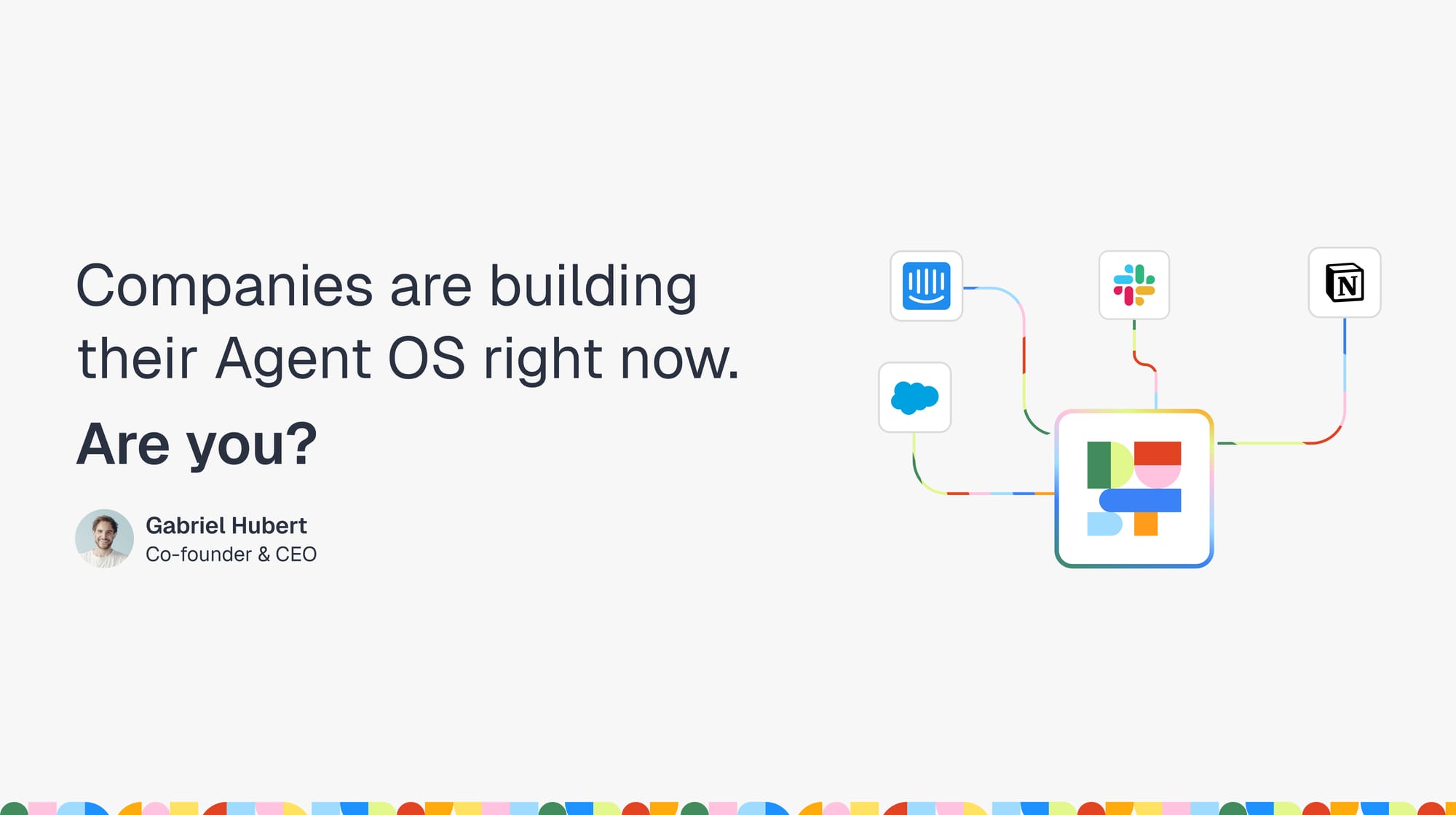Companies are building their Agent OS right now. Are you?

Eric Glyman, CEO of Ramp recently commented that "autonomous finance is being built right now."
What Eric’s seeing in finance teams is just one instance of a much larger change.
At Dust, we're watching this same pattern unfold everywhere, starting with our customer base.
Engineering teams building agents that review code against design docs and internal standards. Legal teams automating contract analysis. People operations teams managing agents that handle the entire onboarding flow. Product teams deploying agents to synthesize feedback from support tickets and user interviews and bringing them into the context of internal roadmap chatter on Slack to produce actionable insights on priorities, … The list goes on.
This is happening today, and the companies building meshing agents into their internal operations and workflows right now are pulling ahead. While changes are sometimes harder to observe from the outside, these companies are building the foundations of a lasting and compounding competitive advantage.
No going back
From Ramp's CEO:
"Then there's the 'we're doing something about what's coming' crowd. The CFO is asking for an AI plan. You're testing different tools, there's an urgency. Meetings are about automating away as much busywork as possible."
We see this exact dynamic, but it's not just the CFO asking for an AI plan, it's every department head or executive. Once a team experiences what it's like to have an agent handle work that used to require hours of manual effort, there's no going back. The old way suddenly feels impossible.
I've experienced this myself: when working on framing an initiative that’s likely to impact multiple systems and product surfaces, I don't start with a new document anymore.
I start by having a conversation with @q, who understands design decisions, Slack discussions, and historical context. @q is an agent that has access to Slack, product documentation, and GitHub repositories. It also knows about our key company goals, and the types of behaviours we’re looking to foster with our users.
@q generates most of the initial framing now. Going back to framing a product decision without that context would feel like typing with mittens on.
The same goes for weekly team meeting content to highlight how we’ve progressed across team, or our monthly investor update. The first draft is is skimmed from all of the content specialized agents have access to, and I’m continuously surprised by topics it chooses to bring up that I would have missed out.
Builders everywhere
What's genuinely exciting to me is that the builders creating and maintaining these agents aren't all engineers. A marketing ops person with no coding background publishing an agent that automatically generates campaign performance reports by pulling data from five different tools. An HR manager creating an agent that answers 90% of employee policy questions without human intervention.
The long-made promise of “no code” augmentation seems to have become reality, and individual human agency is really the only component that’s requires to kick things into gear. This broadening of the the audience of possible “builders” is so valuable. Engineers were gatekeepers for automation and acceleration at Stripe when I worked there ten years ago, and internal productivity projects rarely made it to the top of the priority pile. But the most valuable operational knowledge in your company isn't held by the engineering team alone, instead, it's distributed across every function. Giving these domain experts the tools to encode and share their expertise with agents unlocks value that was previously impossible to capture.
The three phases of agent evolution
What a lot of people miss is that agent organizations don't stay static. They evolve through three distinct phases, and understanding this progression is crucial for long-term success.
Phase 1: Mirroring the org chart (Where most companies start) Right now, people build agents that map 1:1 to existing functions, roles or tasks. "Give me an engineering agent." "Give me a finance agent to review expenses."
The Ramp team painted a picture of specialized finance agents:
"Picture a fleet for different tasks. Expense agents clearing 99%+ of transactions without human touch. Treasury agents optimizing cash positioning. FP&A agents running real-time forecasts."
This approach is a good place to start. Because it mirrors what companies and employees already do, it’s easy to understand and evaluate for the value it creates. Not making rapid progress here is a dominated strategy.
Phase 2: Agents at the seams (Where a growing number of smart companies are moving) Magic happens when you build agents that operate between departments. Sales-to-onboarding handoff agents. Contract renewal anomaly detectors that work between finance, legal and sales. Product agents to ease Support teams work. These agents don't belong to any one team, which is one of the reasons they can provide powerful results: they solve the coordination problems that slow down every company.
Phase 3: The agent network (What we believe is coming) Eventually, we envision a dense web of big and small, human-triggered and system-triggered, interconnected agents that looks nothing like your original human org chart. Some agents, we expect no humans will need to interact with directly. They’ll exist purely to coordinate other agents or to run automated tasks in the background: performing searched to enrich context for example. The company becomes an event-driven system where humans or agents trigger other agents to collaborate on “getting things done”.
These phases mirror to a degree what we’ve observed in software architecture: easy-to-understand monoliths, powerful at-the-seams microservices, and finally complex and interwoven event-driven systems. And just like in software, Phase 3 is where we’re excited to see deeply impactful breakthroughs happen.
Moving to a company-wide Agent OS
We're quickly moving from "What agent should we build?" to "How do we run hundreds of them reliably?"
Companies are seeing an acceleration of the rate of agent creation. They started with one or two experimental agents. Now they're deploying new ones weekly and gradually building a compounding system of agents. If managed well, these systems can allow agents to benefit from richer context, to act more robustly, with clearer patterns, and with more precise success conditions.
The companies pulling ahead are building the infrastructure to design, deploy, monitor, maintain over time and operationally coordinate agent fleets.
The hard part isn't packaging use cases into a verticalised agent anymore. It's running the control plane that keeps hundreds of them secure, in sync, and aligned with business objectives to work and decide faster. That’s the infrastructure that avoids your company's intelligence from stalling on unmapped or unforeseen internal dependencies, but rather turns internal data into a living material that compounds in value.
New infrastructure needs for the agent OS
A company-wide agent OS requires infrastructure that doesn't exist in traditional software. You need:
- Universal context access: Agents need to understand information across Slack, Notion, GitHub, Salesforce, Snowflake, and every other tool your company uses through advanced Retrieval-Augmented Generation (RAG).
- Localised context: Agents need to retrieve localised data to enrich their ambient context through MCP search actions.
- Permission systems designed for agents: Traditional user permissions break down when an HR agent needs to access documents that general employees can't see directly
- Orchestration capabilities: Coordinating fleets of agents requires primitives that don't exist in current platforms but are being built in Dust.
This is why we're building Dust as an operating system. Just like Windows created universal primitives (the clipboard, a file system, window management) that all applications could build on, we're creating the primitives for multiplayer agent orchestration (context access, permission models, agent coordination).
Skills needed: agent orchestration
We believe that agent density (agent count per employee, or task coverage by agents as a ratio of internal tasks completed) will become a primary predictor of company productivity in the years to come. The most successful companies will operate with higher involvement of agents across tasks triggered or completed by human employee. Empowered human talent across fuctions will focus on agent orchestration, putting to work their individual agency, their knack for cross-domain synthesis, complex systems architecture, and great intuition for what to spend time on vs. what to delegate to machines.
The organizational chart was revolutionary when DuPont created a first modern version of it in the 1920s. It supported the rise of large, complex corporations because suddenly, you could coordinate complexity at scale, and hence work and make decisions faster.
But today's org charts assume human limitations: span of control, communication overhead, the need for highly specialized teams and talents, the need for clear hierarchies. AI and agents question these limitations by helping companies and teams coordinate in ways we previously couldn’t leveraging non-human capabilities for summarisation, extraction, analysis, etc… in the flow of business decisions.
We're witnessing a deep change to how companies work: the very nature of talent is being redefined. Rather than automating existing jobs, agents are are changing what makes humans valuable at work, and companies will need to reorganize how humans and agents flock together to take advantage of these changes.
Caution: Agent OS building in progress
The gap between companies embracing this shift and those sitting on the sidelines is broadening. While some companies in 2025 struggle with routine manual processes and avoidable internal human bottlenecks, others in their industry already operate with fleets of specialized agents handling routine work 24/7.
Practical automation and augmentation are already available: models are strong enough today, and improving every couple of months. Infrastructure is mature for most business tasks. The open question is who will step up to build with it with the correct level of ambition for at-scale human/agent collaboration.
At Dust, we're committed to making this transformation accessible to any company that’s decided on empowering their teams to deploy agents as an operating system. Because we believe the future of work isn't about humans versus machines, but about humans orchestrating fleets of intelligent agents to achieve things that were previously too tedious or difficult to manage. Because we believe that companies’ agent OS are being built by teams around us today, one agent at a time.

